
544 COLLECTIONS FEOM T H E AVESTERN IN D IA N OCEAN.
along th e ir in n e r m a rg in s, Avhich are stro n g ly d en ia ted . A m b u la to ry
legs v e ry h a iry and p u b e sc ent, Avitb tb e m e ru s-jo in t s lig h tly compressed,
b u t n o t d ila ted ; d a c ty li u n a rm ed on tb e in fe rio r m a rg in s
an d te rm in a tin g iu a sm a ll corneous claw. Colour (in sp irit)
p in k ish ; h a irs yellowish Avhito. L en g th of carapace n e a rly 2 lin es
(4 millim.), b re a d th abo u t 2 | lines (5 millim.) ; le n g th of th ird
am b u la to ry leg 4 lines (n e a rly 9 m illim.).
Tbe single female iu the collection was obtained at tbe Seychelles
(4 -1 2 fms.).
Tbe species described by A. M.-Edivards as Carcinoplax setosa,
from New Caledonia *, resembles this form in many of its cbaractei’s,
but has a narrower, more arcuate front, and dentated antero-lateral
margins. To it I refer a specimen from the Eijis, Totoya {H.M.S.
‘ Herald’), and perhaps two from tbe Philippines, Pobol {Gaming),
in tbe British-Museum collection.
Ceratoplax arcuata, described in the earlier part of tbis Beport, is
at once distinguisbed by the very differently shaped carapace, acute-
edged eye-peduncles, &c.
61. Grapsus maculatus {Cateshy).
Two adult females of this very common and Avidely distributed
species are in the collection from African Island (No. 210). To
the localities mentioned in my Beport in 1879 on the Transit-of-
Yenus Crustacea {t.c. p. 489), tbe folloAving are to be added:—
Canaries, Teneriffe {Old Collection) ; Lanzarote {Rev. R . T. Lowe);
Aladagascar, Tamatave {Rev. Deans Cowan) ; Amboina {coll. Dr.
Bleelcer) ; and Loyalty Islands, Lifu (Rev. S. J. Whitmee).
This species, as hitherto recorded, ranges throughout tbe Oriental
Begion southward to tbe Cape of Good Hope and New Zealand,
eastward to tbe coasts of California and Peru, and occurs in tbe
Atlantic Begion at the Canary and Cape-Vord Islands and St.
Helena, and on tbo American coasts and islands from Elorida to
Pernambuco {cf. Kingsley, Proc. Acad. Nat. Sci. Philad. p. 193, 1880,
who has shown th at Catesby’s designation maculatus must be used
for this species instead of pictus of Latreille). I have never seen
tbe edition of Catesby’s work published in 1771. In tbe original
and pre-Linnean edition (1743) tbe figure and description are so
bad as to be scarcely recognizable.
62, Grapsus strigosus (Herhst).
Alozamhique, beach (No. 227) ; a small male.
I refer to this common species, which is sometimes scarcely distinguishable
from G. maculatus, specimens in tbe Aluseum collection
from the Bed Sea, Egyptian coast (S ir J. G. Wilkinson) ; Gulf
of Suez (R. AlacAndrew) ; Port Natal (purchased) ; Karachi (the
Karachi Aluseum) ; Duke of York Island (Rev. 0 . Brown); Timor
CRUSTACEA. 545
Laut (H. 0. Forhes); Keeling or Cocos Island (Lt. Bu rn a h y ); Eiji
Islands, Nairai (H.Al.S. ‘ Hercdd’); and Samoa Islands (B e v .S . J .
Whitmee).
From O. maculatus this species seems to be best distinguishable
by its usually broader, less abruptly defiexed front, Avitb straighter
margin, and by tbe more widely transverse, shorter epistoma.
63. Geograpsus grayi (M.-Edw.).
He des Boches, two adult males ; Providence Island, an adult
female (No. 210).
The series in the Museum collection includes specimens from
EgA’pt (S ir J . O. Wilkinson) ; Manritius ; Zanzibar (S ir J . Kirk) ;
Madagascar, Tamatave (Rev. Deans Cowan) ; Ceylon, Galle (Dr.
W. Ondaatje) ; Loyalty Islands, Lifu (Rev. S. J. Whitmee) ;
Mare (W . Wykeham Perry); and Eiji Islands, Matuka (H.M.S.
‘ Herald’).
Mr. Kingsley has already (t. c. p. 196) noted tbe identity of
Geograpsus ruhidus, Stimpson, under which name specimens from
East Africa and Béunion are referred to by Hilgendorf and Hoffmann,
witb G. grayi.
64. Metopograpsus messor (Forskal).
Alabé Island, beach (No. 196) ; a male.
Tbe distribution of tbis common species has been referred to in
tbe preceding part of this Beport (p. 245.) Tbe specimen from Mabé
Island appears to belong to tbe variety designated by M.-Edwards
M. intermedius, characterized by the larger markings of the carapace,
tbe front is only very obscurely denticulated.
Mr. J. S. Kingsley, in bis recent revision of tbe Grapsidæ*,
places tbe Grapsus (Pachygrapsus) oethiopicus, Hilgendorf, as a distinct
species in tbe genus Pachygrapsus, being apparently unaware
th at Hilgendorf has himself admitted tbe correctness of Kossmann’s
identification of this species witb M. messor f .
65. Liolopbus planissimus (Herhst).
Thirteen specimens (among them but one adult male) were
obtained at Darros Island on tbe beach (No. 200), and a very small
male at Etoile Island, 13 fms. (No. 191).
Since my revision of tbe genus in 1878 ] specimens have been
added to the Museum collection from Ascension Island (Staff-
Surgeon T. Gonry); Vizagapatam (A. E. Graven); and tbe Korean
seas (Capt. H. St. John).
* Proc. Acad. Nat. Sci. Philad. p. 200 (1880).
t Hilgendorf, Monatsb. Akad. Wiss. Berlin, p. 808 (1878).
ite 5
J! ifi
j i !■
Hi
> il
nl
* te
}\l i
’ d
si,
I,
I
r ;
A
I
tei I
li
i ii
i;